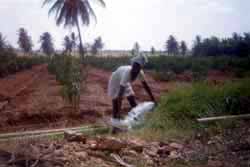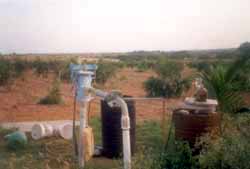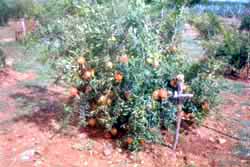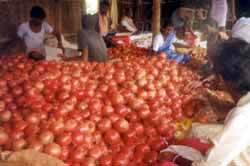III. PROCESS FOR EVALUATION AND ASSESSMENT OF THE GRANT?
Following are our process of evaluation and assessment of the grant.
(i) How the grant has helped the Institution ?
This is the second report we are submitting to the Foundation from the grant 0995-1103. We are proud to indicate that our Department has won laurels by bagging coveted positions and international fellowships: They are:
- Dr MG Chandrakanth, Professor and Chair, of the Department of Agricultural Economics and the PI received World Bank's fellowship in the nation-wide competition to work on (i) Estimation of negative externalities in groundwater irrigation and on (ii) Existence value of sacred groves at the Florida International University, Miami, USA from April to June 2001. During this period, Dr Chandrakanth worked with Dr Mahadev G Bhat and prepared two research papers covering existence value and negative externalities and sent for publication to International conference on environmental and resource economics. The results of acceptance are awaited after March 2002.
- The Indian Society of Agricultural Economics a professional body of Agricultural Economists in India nominated Dr MG Chandrakanth, Professor and Chair, Dept of Agricultural Economics at UAS, Bangalore and PI of the Ford Foundation sponsored project as Vice President of the Society for two years 2000-2002 (letter enclosed).
- This is one of our proudest moments to inform that our Ph.D student, Ms. Deepthi Elizabeth P Kolady, has won the Ford Foundation's International Fellowship Program. She will be working on North-South technology transfer with special reference to seed sectors. Deepthi Elizebeth is one among the thirty scholars from India who have been selected from a tough competition to pursue the doctoral studies in the USA.
- Mrs. MS Suneetha Unnikrishnan pursuing her second her Ph.D has won the Fulbright Pre-Doctoral fellowship on Valuation of natural resources for six months to pursue her research in Cornell University, Ithaca.
- Sri Tamilinian, pursuing PhD is likely to receive fellowship for PhD program in Agricultural Economics at the University of Idaho, USA for three years from Fall 2002.
- Sri H Diwakara and Sri B Shivakumaraswamy, JRFs in the project have been selected to receive fellowship for three years to pursue Ph.D in Institutional economics of water resources in the University of South Australia at Queensland.
- Ms Chithra Gopal Ph.D student will be receiving the fellowship from NATP's CGP to work on Impact of economic liberalization on the seed sector in India.
(ii) Human Resource Development
A workshop on Econometrics Application in NRE was organized by the Department of Agriculture Economics and sponsored by Ford Foundation from 23rd to 27th November. The workshop was conducted by Dr Dhananjaya Arekere, faculty, Texas A and M University, Texas.
Vice Chancellor of the University Dr. A.M.Krishnappa, Dr SR Vishwanath, DR and, P.G.Chengappa, DI inaugurated the workshop. Two books based on research works of Ph.D. scholars in the Department of Agriculture Economics were released on this occasion. The research by G.B.Lokesh was in "A resource economics study of sweet flag in Tumkur district, Karnataka and the research by M.S. Suneetha was in "Demand for and valuation of medicinal plants and products in the Western Ghats of Kerala - A resource economics study. The purpose of the workshop was to introduce software packages like SPSS and LIMDEP to the students and faculty of the University of Agricultural Sciences. Students and faculty of the Department of Agricultural Economics, Department of Statistics, Department of Agricultural Marketing and Extension participated in the workshop.
The concluding session was presided by DI (PGS) Dr Rajagopal and Mr. Harcharan Singh, Additional State Advisor, Government of India. Students who evaluated the workshop said that the workshop had broadened their knowledge and introduced them to tools of Econometrics in NRE. It had educated on the methods to use the data collected and urged for more such programs to go in details.
Prof. M G Chandrakanth was invited to lecture on Impact of Globalization on Agriculture at the Department of Economics, Mangalore, Mangalagangotri on17 Nov, 2001.
Prof. M G Chandrakanth was invited to the AERA Conference on Impact of WTO on Agriculture in India held at New Delhi from 21-23 Nov 2001. Prof. M G Chandrakanth presented a paper on marketing of medicinal plants and sweet flag. The paper was based on research works of Ms Suneetha and Mr. G B Lokesh, students of the Department.
Institute for Wood Science and Technology in Malleshwaram, Bangalore had organized a training workshop for the forest officers. Prof Chandrakanth and Ms Prassanna Rashmi made power point presentations on IPR and Pharmaceuticals and Indigenous Knowledge on 20 Nov 2001.
Dr Chandrakanth actively participated in the academic activities of the Indian Society of Agricultural Economics as its Vice President, during 2000-2001. In addition, in the 61st Annual Conference of Indian Society of Agricultural Economics, which was held in University of Gulbarga, Gulbarga from 27 -29 Dec 2001. Prof. M G Chandrakanth was the rapporteaur for one of the three sessions entitled "Valuation of Natural and Environmental Resources- Methodologies and Estimation (Rapporteaur's report enclosed).
Dr. MG Chandrakanth was the Chairman for the session on "Ecology, Environment and Bio-diversity and Economics and Management of Natural Resources and Common Property Resources" at the International Conference on " Society, politics, the economy and the environment- implications for socio-economic progress in the 21st century" held UAS, Hebbal, Bangalore.
JRFs of the Ford Foundation sponsored project and other students of the Department of Agricultural Economics actively participated in the discussions during the 61st annual conference of the Indian society of Agricultural Economics at Gulbarga during Dec 27-29th, 2001 and were exposed to scholarly discussions in the field of valuation of natural resources.
Dr MG Chandrakanth, PI, participated in the ECOPORT presentation and training program conducted by FAO faculty Mr Peter Griffee on 11th and 13th Feb 2002.
Dr MG Chandrakanth, PI lectured on Natural Resource Economics in the UGC refresher course for college teachers teaching Economics at Central College, Bangalore University in Jan 2002.
The following books were released during 2001:
- Economic Access to groundwater irrigation in watershed development in Karnataka by Bisrat Alemu Mengesha and MG Chandrakanth 2001.
- Synergistic effects of watershed treatments on farm economy through groundwater recharge - A resource economic analysis by MG Chandrakanth and H Diwakara, 2001.
- A resource economics study of sweet flag (Acorus calamus) in Tumkur District, Karnataka.
- Demand for and valuation of medicinal plants and products in the western ghats of Kerala - A resource economics study by MS Suneetha and MG Chandrakanth- 2001.
(iii) Plan of action for the next year
The research work relating to the role of desiltation of irrigation tanks in improving groundwater recharge in the watershed context will be undertaken to appreciate the improvement in the economic access to water resources for resource poor farmers. The resource optimal path of extraction of groundwater in watershed project areas will be linked with valuation of contribution of watershed treatments and efforts of farmers in upstream and downstream locations will be addressed subject to the conditions of cropping intensity, employment opportunity, gender differences and opportunities, technological improvements in extraction and use of groundwater, access to markets, access to insurance, cumulative well interference, social justice and poverty alleviation. Three Junior Research Fellows (Rajendra, Chaitra and Kusha) have already been recruited and the work will begin after the receipt of the second installment of the grant.

 The increasing population of India places increasing demands on water and food.
The contribution of irrigation to growth in agricultural production in India
is 60 percent, since independence (1947). The area irrigated by government canals
is increasing at the rate of 2.4 percent, that by wells is increasing at the
rate of 3.9 percent and area irrigated by irrigation tanks is reducing at the
rate of 0.5 percent. The increase is despite the fact that for every one- percent
increase in the area irrigated, the cost of providing irrigation per hectare
is increasing by 5.8 percent. This implies that there is a lopsided increase
in groundwater abstraction, thus leading to physical and economic scarcity of
groundwater.
The increasing population of India places increasing demands on water and food.
The contribution of irrigation to growth in agricultural production in India
is 60 percent, since independence (1947). The area irrigated by government canals
is increasing at the rate of 2.4 percent, that by wells is increasing at the
rate of 3.9 percent and area irrigated by irrigation tanks is reducing at the
rate of 0.5 percent. The increase is despite the fact that for every one- percent
increase in the area irrigated, the cost of providing irrigation per hectare
is increasing by 5.8 percent. This implies that there is a lopsided increase
in groundwater abstraction, thus leading to physical and economic scarcity of
groundwater.
 The ultimate irrigation potential in India was estimated at 114 million hectares, till 1997, 54 percent of surface water and 30 percent of groundwater are utilized. Thus 70 percent of groundwater still needs to be exploited systematically and sustainably. The most efficient way of utilization of rainwater is to use each drop where nature puts it and the most efficient and cost effective method of storing water is to conserve insitu.
The ultimate irrigation potential in India was estimated at 114 million hectares, till 1997, 54 percent of surface water and 30 percent of groundwater are utilized. Thus 70 percent of groundwater still needs to be exploited systematically and sustainably. The most efficient way of utilization of rainwater is to use each drop where nature puts it and the most efficient and cost effective method of storing water is to conserve insitu.
 Hiriyur taluk in Central Dry Zone of Karnataka is fraught with high probability
of failure of irrigation wells due to cumulative interference and low recharge.
In consonance with this predicament, it was intended to examine the implications
of well failure and the coping strategies adopted by farmers to endure this
situation. In this population study, 48 farmers who were cultivating fig and/or
pomegranate in Hiriyur taluk were chosen.
Hiriyur taluk in Central Dry Zone of Karnataka is fraught with high probability
of failure of irrigation wells due to cumulative interference and low recharge.
In consonance with this predicament, it was intended to examine the implications
of well failure and the coping strategies adopted by farmers to endure this
situation. In this population study, 48 farmers who were cultivating fig and/or
pomegranate in Hiriyur taluk were chosen.
